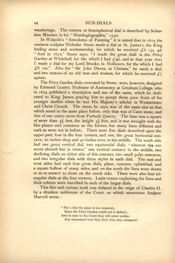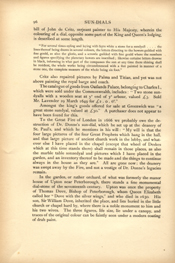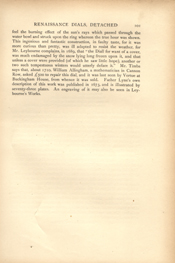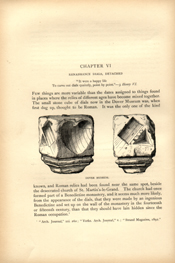
[Full Image]
DOVER MUSEUM.
CHAPTER VI
RENAISSANCE DIALS, DETACHED
"It were a happy life
To carve out dials quaintly, point by point." — 3 Henry VI.
FEW things are more variable than the dates assigned to things found in places where the relics of different ages have become mixed together. The small stone cube of dials now in the Dover Museum was, when first dug up, thought to be Roman. It was the only one of the kind known, and Roman relics had been found near the same spot, beside the desecrated church of St. Martin's-le-Grand. The church had once formed part of a Benedictine monastery, and it seems much more likely, from the appearance of the dials, that they were made by an ingenious Benedictine and set up on the wall of the monastery in the fourteenth or fifteenth century, than that they should have lain hidden since the Roman occupation.1
1 "Arch. Journal," xxi. 262; "Yorks. Arch. Journal," v.; "Strand Magazine, 1892."
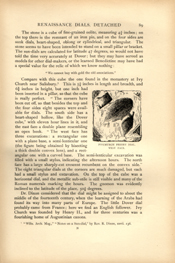
[Full Image]
IVYCHURCH PRIORY DIAL. WEST FACE.
The stone is a cube of fine-grained oolite, measuring 4 3/4 inches; on the top there is the remnant of an iron pin, and on the four sides are sunk dials, heart-shaped, oblong or cylindrical, and triangular. The stone seems to have been intended to stand on a small pillar or bracket. The sun-dials are calculated for latitude 47 degrees, so would not have told the time very accurately at Dover; but they may have served as models for other dial-makers, or the learned Benedictine may have had a special value for the relic of which we know nothing:
| "We cannot buy with gold the old associations." |
Compare with this cube the one found in the monastery at Ivy Church near Salisbury.1 This is 5 3/4 inches in length and breadth, and 6 3/4 inches in height, but one inch had been inserted in a pillar, so that the cube is really perfect. "The corners have been cut off, so that besides the top and the four sides eight spaces were available for dials. The south side has a heart-shaped hollow, like the Dover cube," with eleven hour lines in it, and the east face a double plane resembling an open book. "The west face has three excavations: a rectangular one with a plane base, a semi-lenticular one (the figure being obtained by bisecting a thick double convex lens), and a rectangular one with a curved base. The semi-lenticular excavation was filled with a small stylus, indicating the afternoon hours. The north face has a large sharply-cut crescent recumbent on the convex side." The eight triangular dials at the corners are much damaged, but each had a small stylus and excavation. On the top of the cube was a horizontal dial, and the metallic sub-stile is still visible and many of the Roman numerals marking the hours. The gnomon was evidently inclined to the latitude of the place, 50 3/4 degrees.
Dr. Dixon considered that the dial might be assigned to about the middle of the fourteenth century, when the learning of the Arabs had found its way into many parts of Europe. The little Dover dial probably came from France; here we find an English follower. Ivy Church was founded by Henry II., and for three centuries was a flourishing home of Augustinian canons.
1 "Wilts. Arch. Mag.," "Notes on a Sun-dial," by Rev. R. Dixon, xxvii. 236.
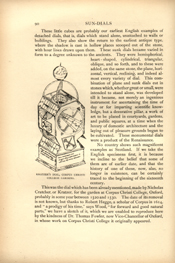
[Full Image]
KRATZER'S DIAL, CORPUS CHRISTI COLLEGE GARDENS.
These little cubes are probably our earliest English examples of detached dials, that is, dials which stand alone, unattached to walls or buildings. They also show the return to the earliest antique type, where the shadow is cast in hollow places scooped out of the stone, with hour lines drawn upon them. These sunk dials became varied in form to a degree unknown to the ancients. They were hemispherical, heart-shaped, cylindrical, triangular, oblique, and so forth, and to these were added, on the same stone, the plane, horizontal, vertical, reclining, and indeed almost every variety of dial. This combination of plane and sunk dials cut in stones which, whether great or small, were intended to stand alone, was developed till it became, not merely an ingenious instrument for ascertaining the time of day or for imparting scientific knowledge, but a decorative pillar, a work of art to be placed in courtyards, gardens, and public squares, at a time when the luxury of domestic architecture and the laying out of pleasure grounds began to be cultivated. These monumental dials were a product of the Renaissance.
No country shows such magnificent examples as Scotland. If we take the English specimens first, it is because we incline to the belief that some of them are of earlier date, and that the history of one of these, now, alas, no longer in existence, can be certainly traced to the beginning of the sixteenth century. This was the dial which has been already mentioned, made by Nicholas Cratcher, or Kratzer, for the garden at Corpus Christi College, Oxford, probably in some year between 1520 and 1530. The date of its removal is not known, but thanks to Robert Hegge, a scholar of Corpus in 1614, and "a prodigy of his time," says Wood, "for forward and good natural parts," we have a sketch of it, which we are enabled to reproduce here by the kindness of Dr. Thomas Fowler, now Vice-Chancellor of Oxford, in whose work on Corpus Christi College it originally appeared.
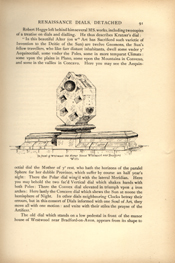
[Full Image]
In front of Westwood Old Manor House Westwood near Bradford Wilts
Robert Hegge left behind him several MS. works, including two copies of a treatise on dials and dialling. He thus describes Kratzer's dial:
"In this beautiful Alter (on wch Art has Sacrificed such varietie of Invention to the Deitie of the Sun) are twelve Gnomons, the Sun's fellow travellers, who like farr distant inhabitants, dwell some vnder ye Aequinoctiall, some vnder the Poles, some in more temparat Climats: some vpon the plains in Plano, some vpon the Mountains in Convexo, and some in the vallies in Concavo. Here you may see the Aequinoctial dial the Mother of ye rest, who hath the horizons of the paralel Sphere for her dubble Province, which suffer by course an half year's night: There the Polar dial wing'd with the lateral Meridian. Here you may behold the two fac'd Vertical dial which shakes hands with both Poles: There the Convex dial elevated in triumph vpon 4 iron arches: Here lastly the Concave dial which shews the Sun at noone the hemisphere of Night. In other dials neighbouring Clocks betray their errours, but in this consort of Dials informed with one Soul of Art, they move all with one motion: and vnite with their stiles the prayse of the Artificer."
The old dial which stands on a low pedestal in front of the manor house of Westwood near Bradford-on-Avon, appears from its shape to

[Full Image]
GREAT FOSTERS.
have carried on the tradition of Kratzer's work. It is covered also with dial hollows of various shapes, and has been thought to date from the seventeenth century. It has possibly been moved of late years into its present position.
The dial-block at Great Fosters near Egham is of nearly the same shape as the above. It is about 2 feet high, 1 foot 8 inches wide, and 10 inches thick. It is placed on a pedestal built of alternate layers of stone of different size, after the style of the seventeenth century. All the faces of the block bear dials of different forms. At the top there is a short column with an iron rod, on which there was once a weather vane. Standing, as this dial-pillar does, in the centre of a smooth green lawn bordered with flowers, and in front of a noble old red-brick Tudor mansion, with great elm trees round it where the rooks build, it looks a fitting accompaniment to a "haunt of ancient peace." The history of the dial is not known, but it is generally called "Sir Francis Drake's dial." In all probability the connection is not with the great sea captain, but with one of the Drakes of Esher Place, which, in 1583, was bought by Richard, third son of John Drake, of Ashe in Devon, the head of the family from which Sir Francis sprang. Richard Drake was succeeded by his son Francis, and he in his turn had a son Francis, who lived at Walton-on-Thames, and died in 1634. These places are only a few miles from Great Fosters House, which about that time belonged to Sir Robert Foster, Chief Justice of the King's Bench, who died in 1663 and was buried at Egham. It is not clear when or from whom Sir Robert bought the place, but he was living there in 1643. Another tradition has it that the house once belonged to a Duke of Northumberland, who drew an armillary sphere, which still remains, on the staircase wall. This would probably be Sir Robert Dudley, son of the Earl of Leicester, on whom the title of Duke of Northumberland was bestowed by the Emperor Ferdinand. He was an ingenious mathematician,1 and many clever instruments designed by him are preserved in the British Museum, at the Institute
1 He was the author of a great work on instruments of navigation, "Del Arcano del Mare," fol., Florence, 1646.

[Full Image]
MADELEY COURT.
of "Studii Superiori" at Florence and elsewhere. The house itself claims a Tudor origin, for Queen Elizabeth's cipher is found there, and Anne Boleyn's badge, but its history cannot be certainly traced beyond Sir Robert Foster's time. The appearance of the dial and its pillar would lead us to connect it with the early part of the seventeenth century, and most probably with Mr. Francis Drake.
Among the entries in the college books of Gonville and Caius College at Cambridge in 1576, there is a notice of a pillar in a courtyard, which was "a stone of marvellous workmanship, containing in itself sixty dials, made by Mr Theodorus Haveas of Cleves, a famous artist and notable exponent of architecture, blazoned with the arms of the nobles who then dined in the college, and dedicated by him to the college as a token of goodwill. On the summit of this stone is placed a winnowing fan, placed like a Pegasus."
The name of Theodorus Haveas has been found at King's Lynn, where he settled with his family. The pillar was standing in 1769 when Loggan's views were taken, but the dials were gone.
The fine cube of stone which stands near the side entrance to Madeley Court, Shropshire, probably belongs to the end of the sixteenth or the early part of the seventeenth century. It stands on four short pillars, mounted on a circular platform, and approached by steps. There is a great concave on three of the four sides, surrounded by smaller hollows of different shapes, and the top is convex. Each of the hollows shows the hour at a certain time of day, and the position of the moon in relation to the planets can also be ascertained. The dials have no history, but the house, which is now divided into dwellings for colliers and their families, was bought from the last prior of Wenlock Abbey by Robert Brooke, Justice of the Common Pleas, and probably rebuilt by him. In the time of Charles I. it belonged to Sir David Brooke, a devoted Royalist and friend of the King; and Charles II. was concealed for a time in a barn at Madeley during some of his
wanderings. The convex or hemispherical dial is described by Sebastian Münster in his "Horologiographia," 1530.
In Walpole's "Anecdotes of Painting" it is stated that in 1619 the eminent sculptor Nicholas Stone made a dial at St. James's, the King finding stone and workmanship, for which he received £6 13s. 4d. "And in 1622," Stone says, "I made the great diall in the Privy Garden at Whitehall, for the which I had £46, and in that year 1622 I made a dial for my Lord Brooke, in Holbourn, for the which I had £8 10s. Also for "Sir John Daves, at Chelsea," he made a dial, and two statues of an old man and woman, for which he received £7 apiece.
The Privy Garden dials, executed by Stone, were, however, designed by Edmund Gunter, Professor of Astronomy at Gresham College, who in 1624 published a description and use of the same, which he dedicated to King James, praying him to accept these poor fruits of his younger studies when he was His Majesty's scholar in Westminster and Christ Church. The stone, he says, was of the same size as that which stood in the same place before, only that was of Caen stone, and this of one entire stone from Purbeck Quarry. The base was a square of more than 4 ½ feet, the height 3 1/4 feet, and it was wrought with the like planes and concaves as the former, but many lines different and such as were not in before. There were five dials described upon the upper part, four in the four corners, and one, the great horizontal concave, 20 inches deep and 40 inches over, in the middle. The south side had one great vertical dial, two equinoctial dials, "whereon the sun never shineth but in winter," one vertical concave in the middle, two declining dials on either side of this concave, two small polar concaves, and two irregular dials with three styles in each dial. The east and west sides had each four great dials, plane, concave, cylindrical, and a square hollow of many sides, and on the north the lines were drawn so as to answer to those on the south side. There were also four triangular dials at the four corners. Latin verses explaining the lines and their colours were inscribed in each of the larger dials.
This fine and curious work was defaced in the reign of Charles II. by a drunken nobleman of the Court, on which occurrence Andrew Marvell wrote:
|
"For a dial the place is too unsecure, Since the Privy Garden could not it defend; And so near to the Court they will never endure Any monument how they their time may misspend." |
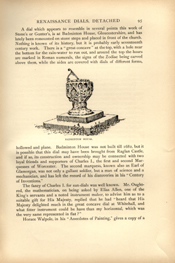
[Full Image]
BADMINTON HOUSE.
A dial which appears to resemble in several points this work of Stone's or Gunter's, is at Badminton House, Gloucestershire, and has lately been remounted on stone steps and placed in front of the church. Nothing is known of its history, but it is probably early seventeenth century work. There is a "great concave" at the top, with a hole near the bottom for the rain-water to run out, and around the top the hours are marked in Roman numerals, the signs of the Zodiac being carved above them, while the sides are covered with dials of different forms, hollowed and plane. Badminton House was not built till 1682, but it is possible that this dial may have been brought from Raglan Castle, and if so, its construction and ownership may be connected with two loyal friends and supporters of Charles I., the first and second Marquesses of Worcester. The second marquess, known also as Earl of Glamorgan, was not only a gallant soldier, but a man of science and a mechanician, and has left the record of his discoveries in his "Century of Inventions."
The fancy of Charles I. for sun-dials was well known. Mr. Oughtred, the mathematician, on being asked by Elias Allen, one of the King's servants and a noted instrument maker, to advise him as to a suitable gift for His Majesty, replied that he had "heard that His Majesty delighted much in the great concave dial at Whitehall, and what fitter instrument could he have than my horizontal, which was the very same represented in flat?"
Horace Walpole, in his "Anecdotes of Painting," gives a copy of a
bill of John de Critz, serjeant painter to His Majesty, wherein the colouring of a dial, opposite some part of the King and Queen's lodging, is described at some length.
"For several times oyling and laying with fayre white a stone for a sundyall.... the lines thereof being drawn in several colours, the letters directing to the howers guilded with fine gould, as also the glorie, and a scrowle guilded with fine gould where the numbers and figures specifying the planetary howers are inscribed; likewise certaine letters drawne in black, informing in what part of the compasses the sun at any time there shining shall be resident, the whole works being circumferenced with a fret painted in manner of a stone one, the complete measure of the whole being six foot."
Critz also repaired pictures by Palma and Titian, and yet was not above painting the royal barge and coach.
The catalogue of goods from Oatlands Palace, belonging to Charles I., which were sold under the Commonwealth, includes: "Two stone sundyalls with a wooden seat at ye end of ye arbour, valued £3. Sold Mr. Lavender 29 March 1649 for £2 . 0 . 6d."
Amongst the king's goods offered for sale at Greenwich was "a great stone sundyal, valued at £30." A purchaser does not appear to have been found for this.
To the Great Fire of London in 1666 we probably owe the destruction of Dr. Donne's sun-dial, which he set up at the deanery of St. Paul's, and which he mentions in his will: "My will is that the four large pictures of the four Great Prophets which hang in the hall, and that large picture of ancient church work in the lobby, and whatever else I have placed in the chapel (except that wheel of Deskes which at this time stands there) shall remain in those places, as also the marble table sonnedyal and pictures which I have placed in the garden, and an inventory thereof to be made and the things to continue always in the house as they are." All are gone now; the deanery was swept away by the Fire, and not a vestige of Dr. Donne's legacies remain.
In the garden, or rather orchard, of what was formerly the manor house of Upton near Peterborough, there stands a fine monumental dial-stone of the seventeenth century. Upton was once the property of Thomas Dove, Bishop of Peterborough, whom Queen Elizabeth called her "Dove with the silver wings," and who died in 1630. His son. Sir William Dove, inherited the place, and lies buried in the little church or chapel hard by, where there is a noble monument to him and his two wives. The three figures, life size, lie under a canopy, and traces of the original colour can be faintly seen under a modern coating of drab paint.

[Full Image]
UPTON, NORTHANTS.
The dial has, fortunately, only been repaired so far as to fasten securely a top stone, which was formerly movable, and covered a concave dial. The whole block is 5 feet 10 inches in height, and 3 feet 4 inches in width at the base moulding. The upper part of the south side is sloped lectern wise; the vertical portion has a heart-shaped hollow. East, west, and north have their several dials, now overgrown with lichen, but it is not many years since the numerals could be distinguished. Not far off from this fine old dial-stone is the stem of a mulberry tree, said to have been planted in Queen Elizabeth's time, and near it are the remains of the old terraces of the garden. Of the manor house only the kitchen is left; its wall is 6 feet thick, and the ivy growing over it has a stem which, from its size, must be some centuries old. The dial was described and sketched with great detail a century ago,1 and it still stands, little altered, in the midst of the quiet fields and old-world surroundings of an out-of-the-way little hamlet.
1 Gibson and Gough's "Castor," "Bib. Top. Brit.," x. 1795; Bridge's "Hist. of Northamptonshire"; "Anastatic Drawing Soc.," vol. xxiv.

[Full Image]
PATRINGTON.
A stone somewhat resembling this at Upton, but which has met with much worse treatment, is now mounted on the gate-post of a farmyard at Patrington, Yorkshire. It is also of the lectern shape, with an oblong hollow on the slope to the south, and a heart-shaped one below. There was once a concave at the top, and oblong, triangular, and circular hollows on the east and west sides; these are all much worn away. The history of the stone has been traced back to 1770, when it was taken out of the remains of an old house which appeared to have once belonged to the Hildyard family. Sir Robert Hildyard, of Patrington, who died 1685, was a Cavalier who fought in the wars on the King's side, compounded for delinquency under the Parliament, and at the restoration of Charles II. was created a baronet. From the appearance of the dial, as well as its history, it would seem likely that it was set up by the old Cavalier in his garden at Patrington, and probably before those civil wars which brought him into close contact with the great lover of dials, Charles I., to whom he was made Gentleman of the Privy Chamber in 1642.1
There are two curious old dial-stones standing in the churchyard at Elmley Castle, Worcestershire. One of these is placed on the eastern side of the burial ground, and is a cube of 1 foot 10 inches, rising to a blunt point, and surmounted by a globular-shaped top; it is covered with hollows of different forms. In several of these hollows there remains a thin iron rod, once the gnomon; in others the rods are beaten flat upon the stone, which is much worn away. The whole height of the dial does not exceed 3 ½ feet. On the plane surfaces of the stone, which is bevelled off at the sides, the remains of two gnomons may be traced by the lead with which they were fixed. Two of the hemispherical hollows have an iron rod fixed across them, and two other hollows contain their metal gnomons, tolerably perfect. When the examination and sketch of this dial was made, about 9 inches of soil had to be cleared away from its base. This was done some years ago, and since then the dial has suffered from weather and school-children, and is much defaced.
The other dial stands near the north-west angle of the churchyard, and is erected on the base and one of the steps of the old cross. On
1 "Transactions of the East Riding Antiquarian Society," vol. v., "Notes on a Sundial at Patrington."

[Full Image]
ELMLEY CASTLE CHURCHYARD.
this foundation there are six courses of stone masonry, rising 2 feet 6 inches in height, and above them is a stone so similar to the dial just described, that it has been conjectured that they might once have formed one structure. Three of the sides have hollows of different shapes, and on the fourth, the north side, is a large shield bearing the arms of Savage, with numerous quarterings; as Walkinton, Danyers, Swinerton, Beke, Stanley, Latham, Arderne, Bagot, Basset, Camvill. These arms were borne by Christopher Savage, to whom the manor of Elmley was granted by Henry VIII. It seems likely that he, or one of his immediate descendants, was the giver of the dial. The family of Savage held land in the parish till within the last twenty or thirty years. At the top of this pillar there is a more modern block, with four vertical dials on it.
In the village of Elmley Castle there is a cubical dial on what seems to have been the shaft of an old cross, and on this the date ADOM CDCXLVIII is inscribed. It stands where two roads meet. The dial-block has unfortunately been placed upside down, probably at the last "restoration." One might read the inscription as A. DO. MCDCXLVIII, which would be a very probable one for the placing of a dialstone on the cross, but not in its present inverted condition.
A dial of the same type as that which bears the Savage arms has been built into the market cross at Wilton. Some part of one of the gnomons remains, but the stone has long ceased to be used as a dial, and we have been unable to find out its history, or even to ascertain when the curious heterogeneous construction which goes by the name of "cross" was erected.
The most beautiful and perfect of all known English dials of this class is at Moccas Court, Herefordshire. It is thought to belong to the reign of Charles II., and was first set up at Mornington Court on the opposite side of the Wye, once the property of the Tompkins family. When this estate came into the possession of the Cornewalls, now represented by the Rev. Sir George Cornewall, Bart., the dial
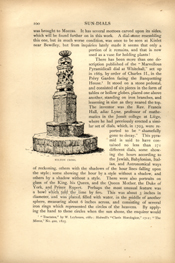
[Full Image]
WILTON CROSS.
was brought to Moccas. It has several mottoes carved upon its sides, which will be found further on in this work. A dial-stone resembling this one, but in much worse condition, was once to be seen at Kinlet near Bewdley, but from inquiries lately made it seems that only a portion of it remains, and that is now used as a vase for holding plants!
There has been more than one description published of the "Marvellous Pyramidicall dial at Whitehall," set up in 1669, by order of Charles II., in the Privy Garden facing the Banquetting House.1 It stood on a stone pedestal, and consisted of six pieces in the form of tables or hollow globes, placed one above another, standing on iron branches, and lessening in size as they neared the top. The inventor was the Rev. Francis Hall alias Lyne, professor of mathematics in the Jesuit college at Liege, where he had previously erected a similar set of dials, which, in 1703, were reported to be "shamefully gone to decay." This pyramid is said to have contained no less than 271 different dials, some showing the hours according to the Jewish, Babylonian, Italian, and Astronomical ways of reckoning, others with the shadows of the hour lines falling upon the style; some showing the hour by a style without a shadow, and others by a shadow without a style. There were also portraits on glass of the King, his Queen, and the Queen Mother, the Duke of York, and Prince Rupert. Perhaps the most unusual feature was a bowl which told the time by fire. This was about 3 inches in diameter, and was placed, filled with water, in the middle of another sphere, measuring about 6 inches across, and consisting of several iron rings which represented the circles of the heavens. By applying the hand to these circles when the sun shone, the enquirer would
1 "Tractates," by W. Leybourn, 1682; Holwell's "Clavis Horologicæ," 1712; "The Mirror," No. 400, 1825.
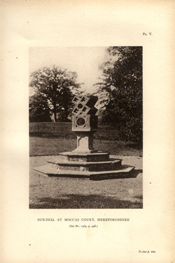
[Full Image]
SUN-DIAL AT MOCCAS COURT, HEREFORDSHIRE
(See No. 1469, p.448)
To face p. 100.
feel the burning effect of the sun's rays which passed through the water bowl and struck upon the ring whereon the true hour was shown. This ingenious and fantastic construction, in faulty taste, for it was more curious than pretty, was ill adapted to resist the weather, for Mr. Leybourne complains, in 1689, that "the Diall for want of a cover, was much endamaged by the snow lying long frozen upon it, and that unless a cover were provided (of which he saw little hope), another or two such tempestuous winters would utterly deface it." Mr. Timbs says that, about 1710, William Allingham, a mathematician in Cannon Row, asked £500 to repair this dial, and it was last seen by Vertue at Buckingham House, from whence it was sold. Father Lyne's own description of this work was published in 1673, and is illustrated by seventy-three plates. An engraving of it may also be seen in Leybournes Works.
